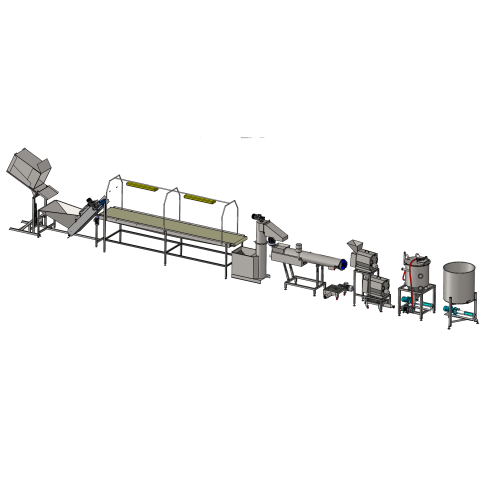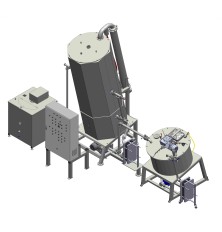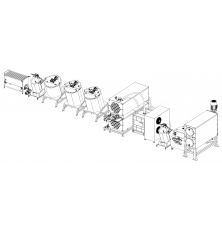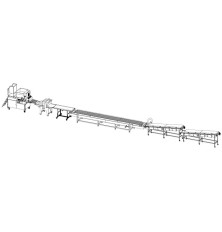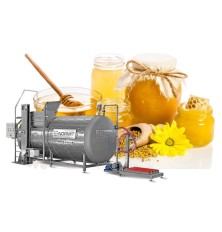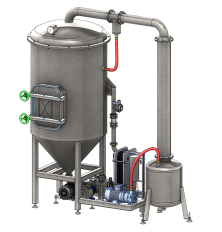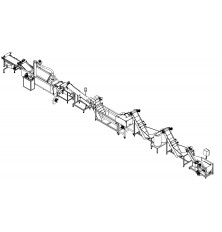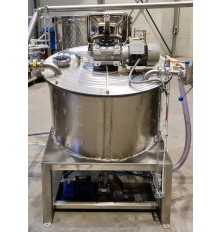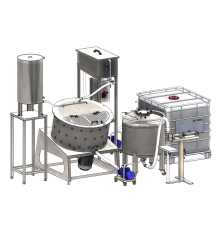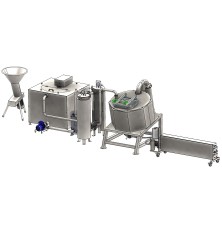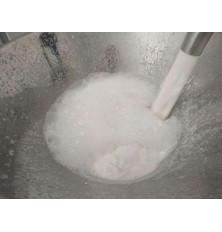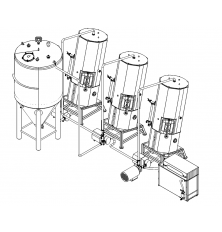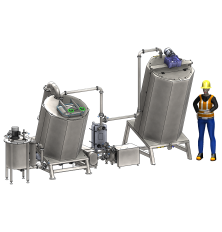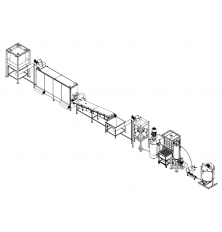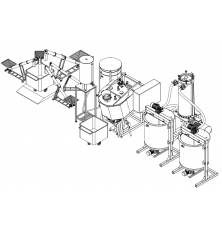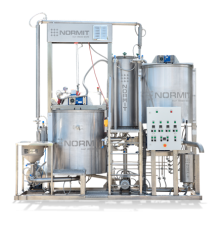Apple puree production line
A production line for making puree from seeded fruits such as apples or pears with a processing capacity of up to 2000 kg/hour of raw materials.
Applesauce is more than just a standalone product commonly featured in a wide variety of fruit-based baby foods; it also holds essential value as a natural component, especially in the production of heat-stable pastry fillings where pectin plays a crucial role.
The applesauce production line includes the following stages:
|
|
|
|
|
|
|
|
Basic version
Apples are loaded into the container of the tipping machine from various plastic or wooden boxes. The tipper is made entirely out of stainless steel and features an automatic hydraulic drive.
This is the first stage of processing, during which core fruits (apples or pears) are fed to the next section, which can be direct washing, inspection, or sorting. In this line for careful processing, the product is fed into a rinsing agent receiving hopper with a conveyor-lift (elevator).
Suitable for various containers with a maximum size of: 120x120x85.
The product is gradually unloaded (in small batches) into the rinsing hopper of the receiver, allowing for the regulation of the workload on the subsequent section - the inspection conveyor. This intermediate step ensures that the product remains undamaged due to its volume, weight, and dimensions, which is particularly important when processing ripe or even overripe raw materials as well as certain soft varieties of apples or pears. Once inside, the elevator lifts the product gradually in portions, with nozzles positioned above supplying water for showering and rinsing the product. A connection to the installation of a water supply source and sewage is necessary. The rinsing process effectively washes away and removes leaves, sand, and stones before unloading onto the inspection conveyor.
One of the most important stages after receiving raw materials is sorting and inspection. This process is usually performed mechanically by operators stationed on either side of the conveyor. The inspection table consists of a conveyor with a PVC conveyor belt, the speed of which can be adjusted using a frequency converter. Lighting lamps are positioned above the belt to assist operators during fruit sorting. The length of the inspection conveyor is determined based on the productivity requirements.
Following inspection, the apples undergo processing in a specialized vertical lift washing machine featuring an auger and a crusher, positioned at the equipment's outlet. This device operates in both continuous and periodic modes, equipped with a robust drive. Depending on the version, the installation may vary in height, incorporate a rotating tower for convenient cleaning, and offer various cutting sieves tailored to different fruit types and desired grinding fractions. This washing and grinding method is specifically designed for core fruits.
To enhance subsequent grinding and obtain apple puree, a blanching process is employed, softening the crushed apples and raising their temperature. This process occurs in a continuous screw blancher with direct injection of purified steam. The product, transported via a screw conveyance mechanism along the entire installations length, undergoes direct scalding with steam - an approach more effective than soaking and lessening raw material loss, as seen in the classic hot water blanching method. Steam imparts its energy to the product swiftly and intensely, softening it without excessive soaking.
The resulting mass is discharged into the receiving hopper of a specialized pump designed for thick products and fruit masses. This monopump can even handle whole berries, featuring a screw conveyor with a hopper and equipped with reverse functionality as well as a control panel.
Utilizing this pump, the softened fruit mass is directed to the destoning section - a process eliminating seeds, peel, and stalks. The production line employs a double destoning system, comprising a two-level installation with two sequential units. The rotor compels the fruit mass through a perforated sieve, separating pulp from the peel, seeds, and stalks. The fruit mass passes through the sieve and is ground into a soft puree. Sieve sizes are chosen based on the specific product, the replacement or washing of the sieve is performed easily. The installation is outfitted with level sensors for the puree storage tank.
Using a special monopump with a hopper, applesauce is fed into the deaerator.
The continuous deaerator serves to degas applesauce, eliminating extraneous odors, preserving its natural color and taste, while also extending its shelf life and reducing the risk of oxidation. The installation features a vacuum system and a dedicated screw pump at the outlet. The installation can be retrofitted with sections of transparent inspection pipelines at the inlet and outlet for visual inspection. The maximum pressure in the vacuum chamber is up to - 0.8 Bar.
After the applesauce has been degassed, it is transferred to a closed buffer tank, which can be supplied with nitrogen to prevent air from being reintroduced into the fruit mass.
Additionally, the following features can be ordered as options:
- flow pasteurization section followed by cooling and Bag in Box filling
- flow freezing section with a dispenser for packaging in large containers (plastic buckets)
- Capacity: 1000 kg/h/ 2000 kg/h
- Material: Stainless steel
- Principle of operation: Continuous mode
- Country of origin: Slovakia









